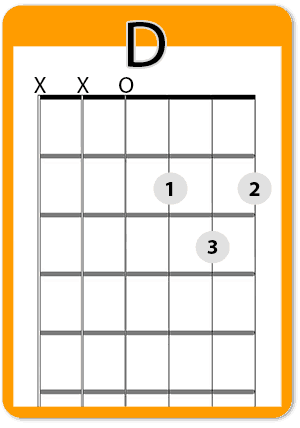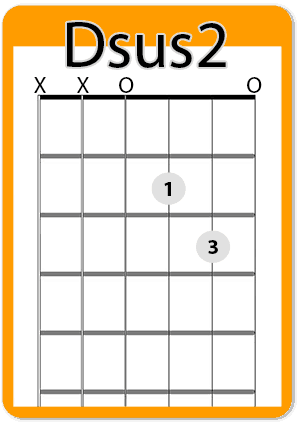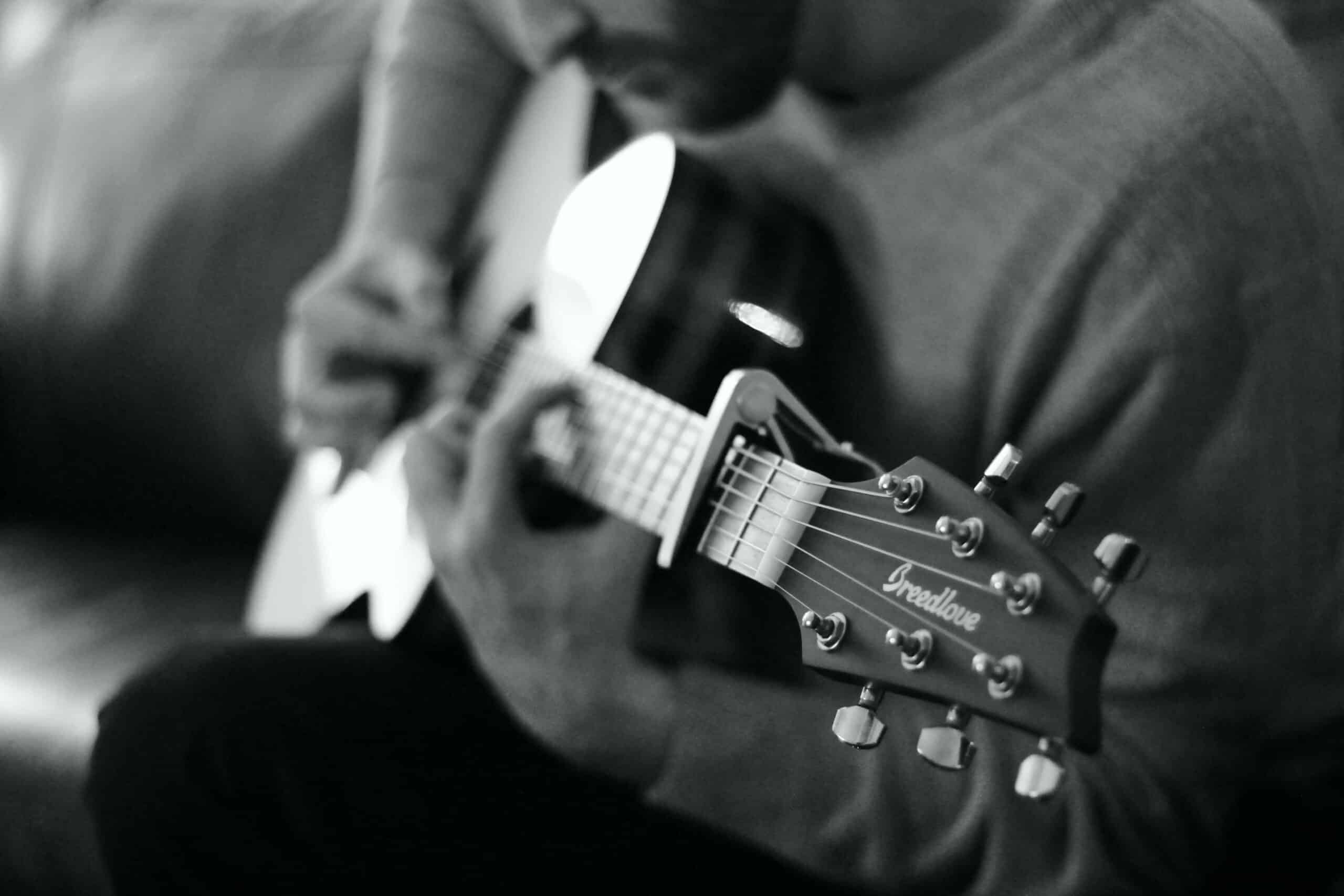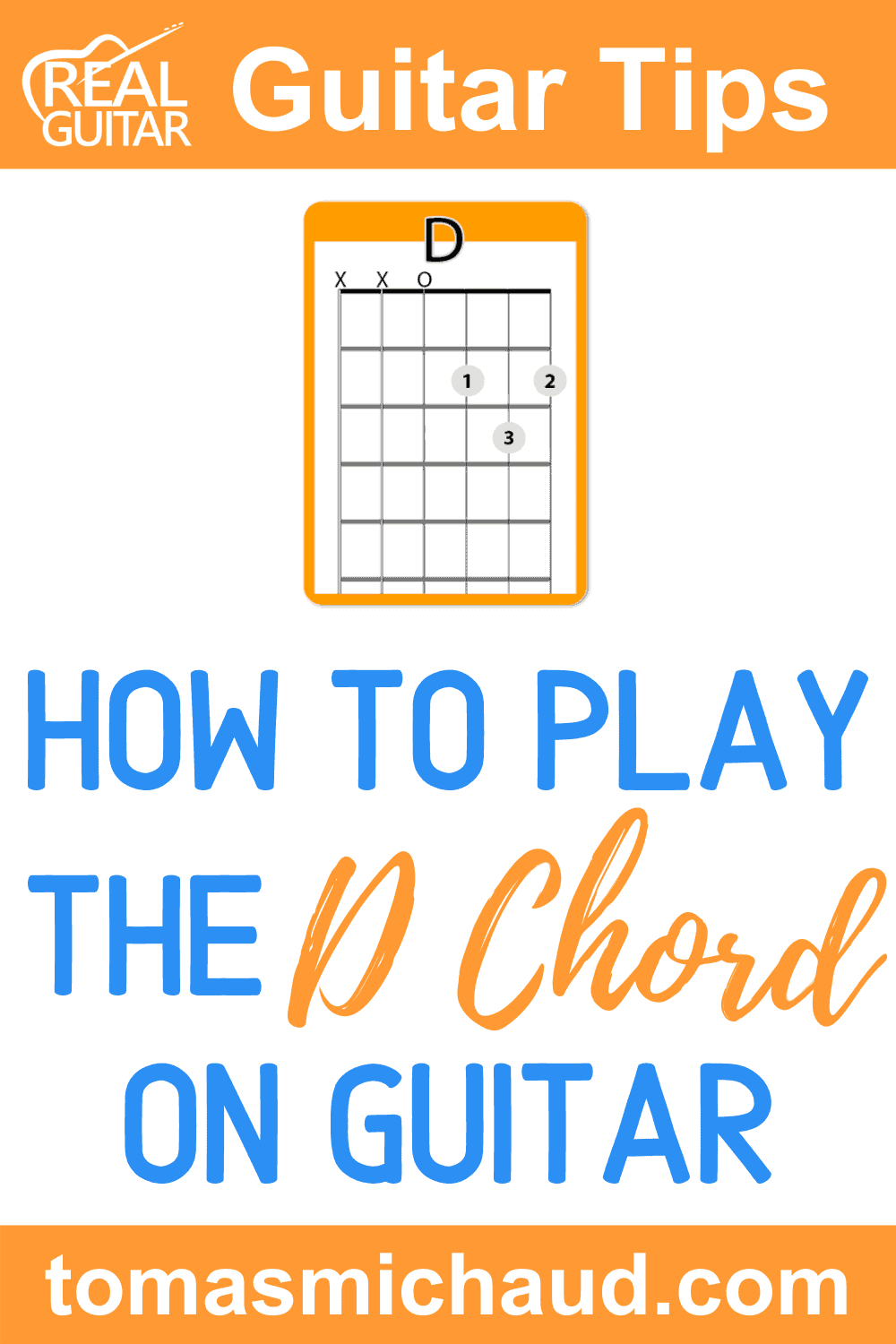Ready to learn the D chord? Great! It's an important chord for beginner guitar players to learn.
The D Major chord is a fundamental chord. It’s one of the 5 Major open chords, which are chords that have at least one open string.
Once you learn the D chord on guitar, make sure to check out the lessons for the C Chord and G chord. They all have a special connection we’ll get to!
The D Chord Finger Position
Here is the D chord fingering for guitar:

The D Major chord is the smallest Major chord. It only uses 4 notes. Let’s form the chord.
1. Place your index (1st) finger on the 3rd string 2nd fret.
2. Place your ring (3rd) finger on the 2nd string 3rd fret.
3. Place your middle (2nd) finger on the 1st string 2nd fret.
You might find it easier to swap the second and third steps. The 4th string will be played open. It might feel like your fingers are bunched up, but that’s OK. It feels less clunky over time.
You’ll only play the first four strings. Strum the chord and make small adjustments as you need to.
*****(If you’d like a review of how to read a chord diagram check this short lesson.)
Where To Place Your Thumb
You might have seen players like Stevie Ray Vaughn, Jimi Hendrix, and Eric Clapton, (to name just a few) have their thumbs hanging over the fretboard when they play. There’s absolutely nothing wrong with this.
When you’re starting out there’s a better way. I recommend this left-hand and thumb position.

The ball of your thumb rests on the back of the neck, with some space between your palm and the neck.
This method gives you more flexibility with chords. It might seem a little awkward at first but it feels natural over time.
The trick is to apply only enough pressure to keep your hand in place. If you squeeze too hard your hand will get sore and fatigue will set in much quicker.

How To Get The D Chord To Sound Better
Here’s a great way to practice the D Major chord.
We’re going to play it with two other forms of the D chord. They’re the Dsus2 chord and Dsus4 chord.
You play them almost the same as D Major.


The easiest way to make them is to start by forming the D Major.
Dsus4
- Form a D Major and place your pinky on the 1st string ,3rd fret
- Keep your middle finger on the 1st string, 2nd fret
- To go back to D simply lift your pinky
Dsus2
- Form a D Major and lift your middle finger
- The 1st string will be played open
- Just like D Major, you’ll only strum the first 4 strings. Let’s practice them together:
- Form a D chord and strum
- Form a Dsus4 by placing your pinky on the 3rd fret, 1st string
- Lift your pinky and strum a D chord
- Lift your middle finger and strum the Dsus2
- The chord progression is D-Dsus4-D-Dsus2. Play it a few times. How does it sound?
You might see these chords notated as D2 or D4. Sometimes you’ll even just see Dsus referenced. That typically means it’s a Dsus2.
If you’re getting buzzing notes you can scoot your finger closer to the fret.
The goal is to get as close to the fret as possible. You’ll notice that on some chords you can only get so close. Just get close enough to let the note ring clearly.
If one of your fingers is touching another string causing dead notes, try adjusting your wrist angle.
You might need to slide your thumb further down the back of the neck a little more to do this. Also, make sure you’re fretting the notes with the tip of your fingers.
What If My Fingers Hurt?

One unavoidable part of playing guitar is the calluses you’ll get on your finger tips. Eventually these will be badges of honor!
But the process can be a little painful. You might also get a sore hand from playing all those chords.
Here are a couple of tips to ease the process.
Keep Proper Thumb Positioning
Try to find that sweet spot for your thumb on the back of the neck. It’s going to be a little different for everyone.
It’s all about finding that balance of comfort and clean notes. Over time you won’t have to think about it and your hand won’t get tired as quickly.
Short Bursts Of Practice
Just like any physical activity, you’ll have to build endurance. You’ll find that your fingers will get sore and your hand will get tired more quickly at first. That’s perfectly normal!
Start out with shorter practice sessions. Even 5-10 minutes of practice goes a long way. Go up to about 30 minutes if you can.
Once you start to get a little too sore take a break. It’s amazing how effective breaks are.
It Gets Easier
The more you play, the more hand strength and endurance you’ll build. So just keep at it!
Adjust Your Guitar
One last practical step is to adjust your guitar to make it easier to play. These steps are often referred to as a setup.
You can do a few of these yourself but you may want to get help from an experienced guitar tech. A properly set up guitar can be a lot more fun to play.
Which version of the Dsus chords do you like best? The Dsus2 or the Dsus4? Let me know in the comments!
Add To Pinterest


